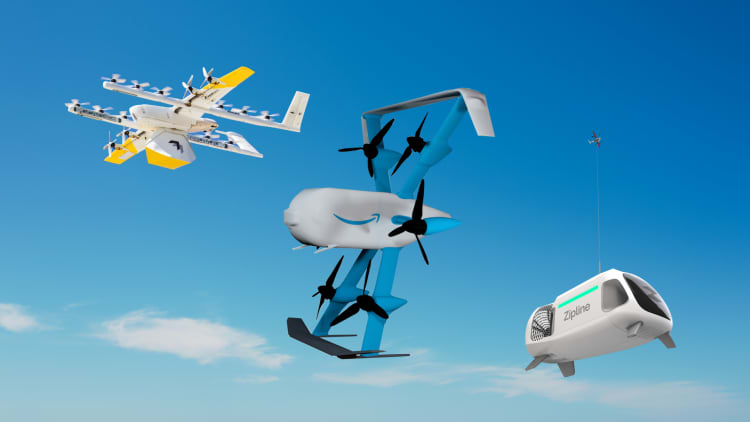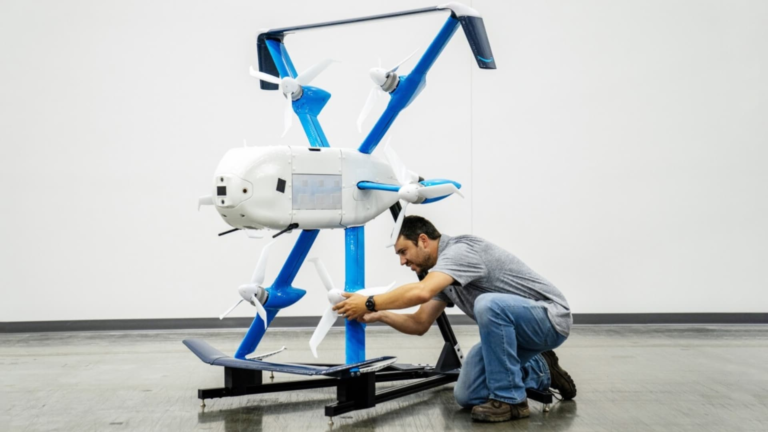Amazon has restarted drone deliveries in two states after a months-long pause, the company confirmed.
In January, Amazon halted Prime Air deliveries in College Station, Texas, and Tolleson, Arizona, the two U.S. markets where it’s testing the service, as the company rolled out a software update to its drone fleet.
Amazon discovered an abnormality with the drone’s altitude sensor, caused by dust in the air, that could have caused its system to produce an inaccurate reading of its position relative to the ground, the company said. Amazon “never experienced an actual safety issue,” but said it opted to suspend deliveries while it corrected the issue.
The company brought drone deliveries back online last week after it completed the software update and received approval from the Federal Aviation Administration, Amazon spokesperson Av Zammit said in a statement.
“Safety underscores everything we do at Prime Air, which is why we paused our operations to conduct a software update on the MK30 drone,” Zammit said. “The updates are now complete and were approved by the FAA, allowing us to resume deliveries.”
An FAA spokesperson didn’t immediately provide a comment.
Zammit said Prime Air has seen “unprecedented levels of demand” since it resumed service. David Carbon, an executive who oversees Amazon’s drone program, wrote in a LinkedIn post last week that the company dropped a bottle of ZzzQuil sleep medicine at an Arizona customer’s home in “31 minutes and 30 seconds.” Carbon didn’t say how far the drone had to fly and Zammit declined to provide details.
For over a decade, Amazon has been working to bring to life founder Jeff Bezos’ vision of drones whizzing toothpaste, books and batteries to customers’ doorsteps in 30 minutes or less. But progress has been slow, as Prime Air has only been made available in the U.S. in College Station and Tolleson. A test site in Lockeford, California, was shuttered last April. The program was also hit with layoffs in 2023 as Amazon CEO Andy Jassy cut costs across the company.
Amazon has set a goal to deliver 500 million packages by drone per year by the end of the decade. The company last year notched a critical regulatory milestone that could enable it to accelerate deliveries. It’s eyed international expansion to the U.K., and recently welcomed Transportation Secretary Sean Duffy in a visit to a Prime Air facility.
The company also introduced a new version of its delivery drone, called the MK30, which is designed to be quieter than previous models and can fly in light rain.
Customers in College Station, a quiet suburban town that’s about 100 miles northwest of Houston, had previously complained about the drones’ noise levels. After rolling out the MK30, the company is also taking steps to relocate its drone hub farther away from residents’ homes later this year.
Before Amazon suspended drone deliveries, the MK30 crashed in two separate incidents during test flights at the company’s facility in Pendleton, Oregon. Last December, a software issue caused two drones to crash, according to Bloomberg. And in September, a pilot mistakenly caused a “mid-air collision” between two drones after he tested how the MK30 would perform when faced with a failed propeller, according to a federal crash report.
Another crash occurred on Feb. 21 during tests at the Pendleton site, which resulted in a drone sustaining substantial damage, according to a report compiled by the National Transportation Safety Board.
Amazon said the crashes were unrelated to its decision to halt drone operations. The company has said these kinds of incidents, which have also occurred with other models in previous years, are part of the testing process, as it pushes drone systems “up to the limits and beyond.”
WATCH: Amazon, Alphabet’s Wing and Zipline race to roll out drone delivery


